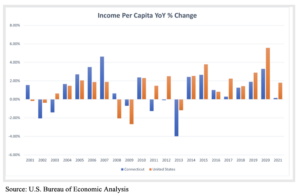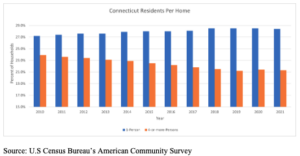There are a variety of fallacies regarding income in the United States perpetuated by politicians, academia and the media — but one more egregious falsehood is that household incomes in the United States have become stagnant over the last half century despite economic expansion.
For example, CBS News on September 10th, 2019, stated: “Americans’ household income is barely rising despite ongoing economic growth and low unemployment, a sign the typical family is failing to see significant gains from what has been a record-long expansion.”
This notion has been repeated one way or another so many times that it feels as though it’s true. Compounded by the fact that a large portion of the data used to justify this conclusion comes from government affiliated agencies, and you have a fallacy that holds a certain level of truth, thereby allowing hysteria.
But what is the real truth?
CBS News was right in stating that “household income is barely rising.” In fact, one can say that over time, household income has stagnated. Data from the U.S. Census Bureau concludes that the real (accounting for inflation) median household income has only risen 7 percent between the years 2000 to 2021. When viewing the same statistics for Connecticut, the median household income only rose 2 percent. At the same time, both the United States and Connecticut experienced robust real income per capita growth with the former gaining 33 percent and the latter, 22 percent.
How is it that the median household income has stagnated, yet per capita income has experienced strong growth? It is because, over time, American households have grown smaller.
In 1960, 13 percent of households had one resident; by 2021, that number had more than doubled. On the opposite side of the spectrum, in 1960, 40.2 percent of homes had four or more residents, this number had dropped to 21.7 percent by 2021. Connecticut is no exception as it has been following the same trend with an increase in one resident households and a decrease in homes consisting of four or more residents. In fact, the state has been slightly outpacing the rest of the country in its diminishing home size as the percentage of homes consisting of four or more people had contracted from 23.9 percent to 21.3 percent from 2010 to 2021, while the United States contracted from 23.8 percent to 21.7 percent, respectively. This statistic may attribute itself as a fraction of the reason why Connecticut has seen a slower paced growth in its median household income.
As the number of individuals living under one roof decreases so will the aggregate income of that house. Therefore, household income is a function of total residency and caution should be used when using it to analyze the standard of living. Instead, income per person should be utilized as it is a more confidence inspiring measure because of the consistency of its meaning.
By accounting for this issue, we can conclude that the growth in Connecticut’s standard of living portrayed by per capita income is 11 times greater than that portrayed by the median household income. But in comparison to the rest of the country, the Constitution State is lagging in both metrics thereby signifying a more lackadaisical economy.
Sources:
Median Household Income in Connecticut (MEHOINUSCTA646N) | FRED | St. Louis Fed (stlouisfed.org)
Per Capita Personal Income in Connecticut (CTPCPI) | FRED | St. Louis Fed (stlouisfed.org)
household size – Census Bureau Tables
U.S. Census data: Median income for Americans was flat last year despite economic growth – CBS News
Historical Households Tables (census.gov)
BEA Interactive Data Application
To read more of Kris Wright’s analyses, follow him on his Substack here.



